United Online® Reports Fourth Quarter and Full-Year 2008 Results
| • | Record Quarterly Adjusted OIBDA in Q4 2008 and Seventh Consecutive Annual Record for Adjusted OIBDA in 2008, Excluding FTD for Comparability | ||
| • | GAAP Operating Losses in Q4 2008 and Full-Year 2008 as a Result of Non-Cash Impairment Charges | ||
| • | Record Fourth Quarter Net Growth of 232,000 Classmates Media Segment Pay Accounts Results in Record 1.1 Million Net Growth in Segment Pay Accounts for Full-Year 2008 |
WOODLAND HILLS, Calif., Feb 19, 2009 (BUSINESS WIRE) -- United Online, Inc. (Nasdaq:UNTD), a leading provider of consumer products and services over the Internet, today reported financial results for its fourth quarter and year ended December 31, 2008. The 2008 fourth quarter results include three months of operations from FTD Group, Inc. ("FTD"), acquired on August 26, 2008, that were not included in the company's financial results for the fourth quarter ended December 31, 2007.
"United Online achieved new record levels of quarterly and annual adjusted OIBDA in the fourth quarter and full-year 2008, excluding the recent FTD acquisition to ensure comparability with prior-year periods, which marks our seventh consecutive year of record adjusted OIBDA," commented Mark R. Goldston, Chairman, President and Chief Executive Officer of United Online. "Considering the challenging economic environment, it is gratifying to achieve such strong performance in adjusted OIBDA and cash flow, which has become a hallmark of the company."
"Our Classmates Media and Communications segments once again performed very well in the fourth quarter, further demonstrating their attractive value propositions for consumers and the resiliency of their subscription business models," Goldston added. "Driven by the continued success of our social networking business, our Classmates Media segment delivered a strong fourth quarter that increased our segment adjusted OIBDA for the full year 2008 to a record $60.1 million, up 71% versus the prior year. In addition, in the fourth quarter, our Communications business, which we continue to operate for profitability and cash flows, experienced its lowest decline in net pay accounts in over three years."
"Our FTD segment results for the fourth quarter reflect both the weakening consumer spending environment, which we have continued to experience in the first quarter of 2009, and the strengthening of the U.S. Dollar against the British Pound throughout the fourth quarter. We expect that adverse macroeconomic factors in both the U.S. and U.K. will continue to negatively impact the FTD segment, at least in the near term, which is reflected in our adjusted OIBDA guidance for the first quarter. Primarily as a result of the adverse change in economic conditions and equity market dynamics since we acquired FTD in August 2008, we recorded non-cash impairment charges of $175.9 million during the fourth quarter to write down the carrying value of goodwill and certain intangible assets of FTD. However, we continue to be excited about our new marketing initiatives within the FTD segment and our ability to enhance our competitive position."
Summary Results for Fourth Quarter and Year Ended December 31, 2008:
The following table summarizes key financial results for the fourth quarter and year ended December 31, 2008. The results include FTD from August 26, 2008, the date of acquisition.
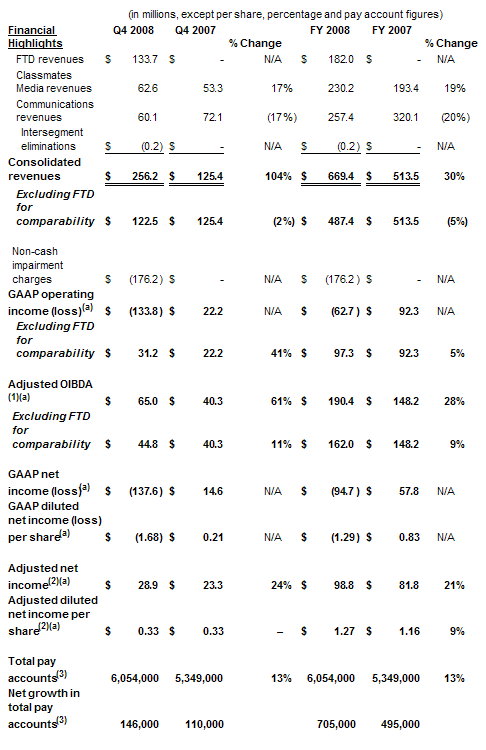
| • | Consolidated revenues for the fourth quarter and full-year 2008 were $256.2 million and $669.4 million, increases of 104% and 30% versus the prior-year comparable periods, respectively. The increases were primarily attributable to the FTD acquisition in August 2008. | ||
| • | Excluding the FTD segment for comparability purposes, revenues for the fourth quarter were $122.5 million, a decrease of 2% versus the prior-year comparable quarter. This represents the lowest year-over-year decrease in five quarters. | ||
| • | Classmates Media segment revenues exceeded Communications segment revenues during the fourth quarter for the first time, as Classmates Media segment revenues increased by 17% while Communications segment revenues declined by 17% when compared to the prior-year comparable period. | ||
| • | Adjusted OIBDA for the fourth quarter and full-year 2008 increased to quarterly and annual records of $65.0 million and $190.4 million, increases of 61% and 28%, respectively, versus the prior-year comparable periods. The increases were primarily attributable to the FTD acquisition. | ||
| • | Excluding FTD for comparability with the prior year, adjusted OIBDA in the fourth quarter and full-year 2008 was $44.8 million and $162.0 million, increases of 11% and 9%, respectively, versus the prior-year comparable periods. | ||
| • | The company recorded non-cash impairment charges of $175.9 million ($153.7 million net of tax, or $1.88 and $2.10 per diluted share, for the fourth quarter and full year 2008, respectively) reflecting the amount by which the carrying value of goodwill and certain intangible assets related to the company's FTD segment exceeded their estimated fair values. The company also recorded non-cash impairment charges of approximately $0.3 million associated with the Communications segment. | ||
| • | GAAP diluted net loss per share for the fourth quarter and full-year 2008 was ($1.68) and ($1.29), respectively, which reflect the non-cash impairment charges described above. GAAP diluted net income per share for the fourth quarter and full-year 2007 was $0.21 and $0.83, respectively. | ||
| • | Adjusted diluted net income per share for the fourth quarter and full-year 2008 was $0.33 and $1.27, unchanged and an increase of 9%, respectively, versus the prior-year comparable periods. | ||
| • | Pay accounts totaled a record 6.1 million at December 31, 2008, a net increase of 705,000, or 13%, from 5.3 million at December 31, 2007. The fourth quarter represents the first period in which total pay accounts exceeded 6 million. |
|
(a) |
Fourth Quarter 2008: financial results (GAAP and non-GAAP) include a reduction in general and administrative expenses as a result of a favorable net settlement of $3.3 million ($2.1 million, or $0.02 per diluted share, net of tax) related to a non-income tax dispute for prior periods. GAAP results also include the non-cash impairment charges referenced above. | |
|
Fourth Quarter 2007: financial results (GAAP and non-GAAP) include $1.0 million in costs related to the proposed initial public offering ("IPO") of the company's Classmates Media Corporation ("CMC") subsidiary. Fourth quarter 2007 GAAP financial results also include $3.0 million ($1.8 million, or $0.03 per diluted share, net of tax) in restructuring costs. | ||
|
Full-Year 2008: financial results (GAAP and non-GAAP) include the fourth quarter 2008 items referenced above as well as the write off of $3.9 million ($2.4 million, or $0.03 per diluted share, net of tax) in deferred transaction costs related to the proposed IPO of CMC. | ||
|
Full-Year 2007: financial results (GAAP and non-GAAP) include the fourth quarter 2007 items referenced above as well as an additional $2.7 million ($1.6 million, or $0.02 per diluted share, net of tax) in costs related to the proposed IPO of CMC. | ||
Neil P. Edwards, Acting Chief Financial Officer, commented, "Our strong cash flow generation during the fourth quarter increased our cash position to more than $104 million at year end while achieving a nearly $10 million reduction in our debt balance during the quarter. The further strengthening of our cash position and reduction in our debt balance during the fourth quarter demonstrates our financial capacity to service the debt on our balance sheet and pay a meaningful dividend, while we continue to invest prudently in initiatives to benefit the company as we move forward."
Cash Flows, Balance Sheet and Dividend Highlights:
| • | Cash flows from operations increased 95% to $63.5 million and 29% to $164.0 million in the fourth quarter and full-year 2008, respectively, versus the comparable prior-year periods. The increases were primarily attributable to the FTD acquisition. | ||
| • | Free cash flow(4) increased 95% to $55.0 million and 34% to $145.0 million in the fourth quarter and full-year 2008, respectively, versus the comparable prior-year periods. The increases were primarily attributable to the FTD acquisition. | ||
| • | Cash and cash equivalents at December 31, 2008 increased to a combined $104.5 million from $69.7 million at September 30, 2008, representing a net increase of $34.8 million during the fourth quarter. | ||
| • | Total debt, net of discounts, at December 31, 2008 was $413.5 million, a decrease of $9.6 million versus $423.1 million at September 30, 2008. | ||
| • | During the fourth quarter and year ended December 31, 2008, the company paid $8.7 million and $53.1 million in cash dividends, respectively. | ||
| • | The company's board of directors recently declared a quarterly cash dividend for the 16th consecutive quarter. The $0.10 cash dividend is payable on February 27, 2009 to shareholders of record on February 13, 2009. |
Segment Results for Fourth Quarter and Year Ended December 31, 2008:
FTD:
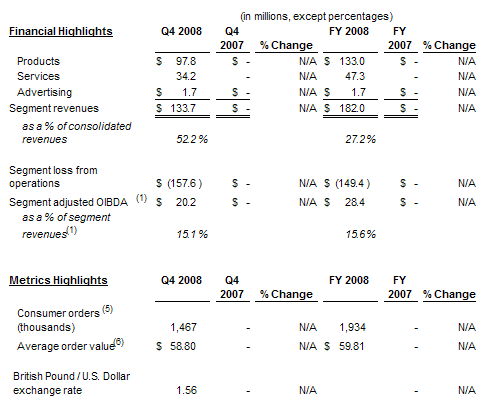
| • | Full-year 2008 results reflect the period from August 26, 2008 (the acquisition date) through December 31, 2008. | ||
| • | Quarterly revenues, consumer orders and average order valuefor certain quarterly periods prior to United Online's acquisition of FTD, as previously reported by the predecessor FTD company, are included in the tables accompanying this press release as supplemental disclosures for comparison purposes. | ||
| • | Segment revenues were $133.7 million in the fourth quarter, a 14% decrease compared to revenues of $155.5 million for the quarter ended December 31, 2007 as reported by the predecessor FTD company. Excluding a $10.6 million foreign currency exchange rate impact resulting from the strengthening U.S. Dollar versus the British Pound, segment revenues for the 2008 fourth quarter decreased 7% versus the year-ago comparable quarter. | ||
| • | Segment adjusted OIBDA(1) was $20.2 million in the fourth quarter, representing 15.1% of segment revenues. | ||
| Consumer orders during the fourth quarter were 1,467,000, a 5% decrease versus 1,540,000 consumer orders for the quarter ended December 31, 2007 as reported by the predecessor FTD company. | |||
| • | Average order value ("AOV") was $58.80 in the 2008 fourth quarter, versus $65.48 for the quarter ended December 31, 2007 as reported by the predecessor FTD company. The strengthening U.S. Dollar versus the British Pound contributed to the majority of the decline in AOV in the 2008 fourth quarter versus the prior-year comparable quarter reported by the predecessor company. |
Classmates Media:

| • | Segment revenues increased 17% to a record $62.6 million and 19% to $230.2 million in the fourth quarter and full-year 2008, respectively, versus the prior-year comparable periods. | ||
| • | The segment represented 24.4% of consolidated revenues in the 2008 fourth quarter. | ||
| • | Segment adjusted OIBDA for the fourth quarter and full-year 2008 increased to quarterly and annual records of $22.0 million and $60.1 million, respectively, an increase of 63% and 71%, respectively, versus the prior-year comparable periods. | ||
| • | Segment adjusted OIBDA as a percentage of segment revenues for the fourth quarter and full-year 2008 increased to quarterly and annual records of 35.2% and 26.1%, respectively. The increases primarily reflect operating leverage associated with higher segment revenues. | ||
| • | Pay accounts increased by a net 232,000 during the fourth quarter, up from net growth of 216,000 in the year-ago comparable quarter, and represented the company's best-ever performance during a fourth quarter. | ||
| • | Pay accounts as of December 31, 2008 were a record 4.3 million, an increase of 35% versus 3.2 million at December 31, 2007. | ||
| • | Segment active accounts(3) were a record 16.0 million in the fourth quarter, an increase of 27% versus 12.6 million in the year-ago comparable quarter. |
|
(b) |
Fourth Quarter 2008: financial results (GAAP and non-GAAP) include a reduction in general and administrative expenses as a result of a favorable net settlement of $3.3 million related to a non-income tax dispute for prior periods. | |
|
Full-Year 2008: financial results (GAAP and non-GAAP) include the fourth quarter 2008 item referenced above as well as the write off of $3.9 million in deferred transaction costs related to the proposed IPO of CMC. | ||
|
Fourth Quarter 2007 and Full-Year 2007: financial results (GAAP and non-GAAP) include $1.0 million and $3.7 million in costs, respectively, related to the proposed IPO of CMC. |
Communications:
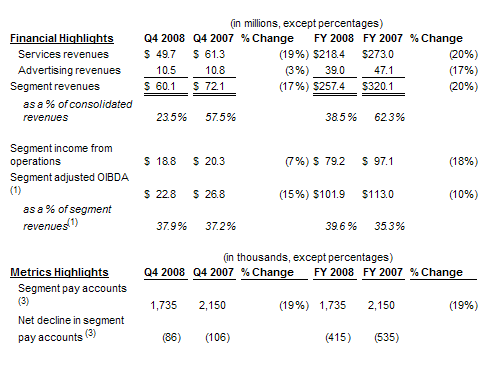
| • | Segment revenues decreased 17% to $60.1 million and 20% to $257.4 million in the fourth quarter and full-year 2008, respectively, versus the prior-year comparable periods. | ||
| • | The segment represented 23.5% of consolidated revenues in the 2008 fourth quarter, versus 57.5% in the prior-year comparable period. | ||
| • | Segment adjusted OIBDA for the fourth quarter and full-year 2008 decreased 15% to $22.8 million and 10% to $101.9 million, respectively, versus the prior-year comparable periods. | ||
| • | Segment adjusted OIBDA for the fourth quarter and full-year 2008 increased to 37.9% and a record 39.6%of segment revenues, respectively. The increases versus 37.2% and 35.3% of segment revenues in the fourth quarter and full-year 2007, respectively, reflect the company's continuing efforts in expense management and driving profitability and cash flows. | ||
| • | Pay accounts decreased by a net 86,000 during the 2008 fourth quarter, the lowest net decline in more than three years. In the fourth quarter of 2007, pay accounts declined by a net 106,000. | ||
| • | Segment pay accounts as of December 31, 2008 were 1.7 million, a decrease of 19% versus 2.2 million at December 31, 2007. | ||
| • | Segment pay account churn decreased to a record low 4.3% in the fourth quarter, versus 4.4% in the prior-year comparable quarter. |
Business Outlook:
The following forward-looking information includes certain projections made by management as of the date of this press release. The company does not intend to revise or update this information and may not provide this type of information in the future. Due to a variety of factors, actual results may differ significantly from those projected. Factors include, without limitation, the factors referenced later in this announcement under the caption "Cautionary Information Regarding Forward-Looking Statements." In particular, our projections are premised on an exchange rate of 1.4 U.S. Dollars to 1.0 British Pounds for the first quarter and any change in the exchange rate could have a material impact on our projections. These and other factors are discussed in more detail in the company's filings with the Securities and Exchange Commission.
The company is providing adjusted OIBDA guidance in the range of $53 million to $58 million for the quarter ending March 31, 2009.
The table below reconciles the company's guidance for operating income, a GAAP measure, to adjusted OIBDA.

Investor Conference Call Today at 5:00 p.m. ET (2:00 p.m. PT):
United Online will host a conference call today at 5:00 p.m. ET (2:00 p.m. PT) to discuss its quarterly and full-year results. To participate, please dial 888-587-0611 (or 719-325-2438 outside the U.S.), and provide the confirmation code, 4759586. A live webcast of the call, along with a presentation containing financial highlights for the quarter and full-year ended December 31, 2008, can also be accessed through the "investors" section of the company's Web site located at www.unitedonline.com. The presentation and a replay of the broadcast will be available on the Web site for seven days, or by dialing 888-203-1112 (or 719-457-0820 outside of the U.S.) and the confirmation code, 4759586.
Definitions of Non-GAAP Financial Measures and Selected Metrics:
(1) Adjusted operating income before depreciation and amortization (adjusted OIBDA) is defined by the company as operating income before depreciation; amortization; stock-based compensation; restructuring and related charges; and impairment of goodwill, intangible assets and long-lived assets. The company's definition of adjusted OIBDA has been modified from time to time. Management believes that because adjusted OIBDA excludes (1) certain non-cash expenses (such as depreciation, amortization, stock-based compensation, and impairment of goodwill, intangible assets and long-lived assets); and (2) expenses that are not reflective of the company's core operating results over time (such as restructuring and related charges), this measure provides investors with additional useful information to measure the company's financial performance, particularly with respect to changes in performance from period to period. Management uses adjusted OIBDA to measure the company's performance. The company's board of directors has used this measure as a basis in determining certain compensation incentives for certain members of the company's management. Adjusted OIBDA is not determined in accordance with accounting principles generally accepted in the United States of America ("GAAP") and should be considered in addition to, not as a substitute for or superior to, financial measures determined in accordance with GAAP. A limitation associated with the use of adjusted OIBDA is that it does not reflect the periodic costs of certain tangible and intangible assets used in generating revenues in the company's business. Management evaluates the costs of such tangible and intangible assets through other financial activities such as evaluations of capital expenditures and purchase accounting. An additional limitation associated with this measure is that it does not include stock-based compensation expenses related to the company's workforce. Management compensates for this limitation by providing a summary of stock-based compensation expenses on the face of the consolidated statements of operations. A further limitation associated with the use of this measure is that it does not reflect the costs of restructuring and related charges and the impairment of goodwill, intangible assets and long-lived assets. Management compensates for this limitation by providing supplemental information about restructuring and related charges and impairment charges within its financial press releases and Securities and Exchange Commission ("SEC") filings, when applicable. An additional limitation associated with the use of this measure is that the term "adjusted OIBDA" does not have a standardized meaning. Therefore, other companies may use the same or a similarly named measure but exclude different items or use different computations, which may not provide investors a comparable view of the company's performance in relation to other companies. Management compensates for this limitation by presenting the most comparable GAAP measure, operating income, directly ahead of adjusted OIBDA within its financial press releases and by providing a reconciliation that shows and describes the adjustments made. A reconciliation to operating income is provided in the accompanying tables.
Adjusted OIBDA for each of the company's segments is defined by the company as segment income from operations, as set forth in the company's Forms 10-K and Forms 10-Q, before stock-based compensation, restructuring and related charges and the impairment of goodwill, intangible assets and long-lived assets. The company's definition of adjusted OIBDA for each of the company's segments has been modified from time to time. Management believes that because segment adjusted OIBDA and segment adjusted OIBDA as a percentage of segment revenues exclude (1) certain non-cash expenses (such as stock-based compensation, and the impairment of goodwill, intangible assets and long-lived assets); and (2) expenses that are not reflective of the segment's core operating results over time (such as restructuring and related charges), these measures provide investors with additional useful information to evaluate the company's segment financial performance, particularly with respect to changes in performance from period to period. Segment adjusted OIBDA and segment adjusted OIBDA as a percentage of segment revenues are not determined in accordance with GAAP and should be considered in addition to, not as a substitute for or superior to, financial measures determined in accordance with GAAP. A limitation associated with these measures is that they do not include stock-based compensation expenses related to the company's workforce. Management compensates for this limitation by providing a summary of stock-based compensation expenses on the face of the consolidated statements of operations. A further limitation associated with the use of these measures is that they do not reflect the costs of restructuring and related charges and impairment charges related to an operating segment. Management compensates for this limitation by providing supplemental information about restructuring and related charges and impairment charges by segment within its financial press releases and SEC filings, when applicable. A reconciliation to segment income from operations, its most comparable GAAP financial measure, is provided in the accompanying tables.
(2) Adjusted net income is defined by the company as net income before the after-tax effect of: stock-based compensation; amortization of intangible assets; restructuring and related charges; impairment of goodwill, intangible assets and long-lived assets; and the cumulative effect of a change in accounting principle as a result of the adoption of SFAS 123R, and the re-measurement of certain deferred tax assets. Management believes that adjusted net income and adjusted diluted net income per share provide investors with additional useful information to measure the company's financial performance, particularly with respect to changes in performance from period to period, because these measures are exclusive of (1) certain non-cash expenses (such as stock-based compensation, amortization, the cumulative effect of change in accounting principle, and the impairment of goodwill, intangible assets and long-lived assets); and (2) expenses that are not reflective of the company's core results over time (such as restructuring and related charges). Management also uses adjusted net income and adjusted diluted net income per share for this purpose. Adjusted net income and adjusted diluted net income per share are not determined in accordance with GAAP and should be considered in addition to, not as a substitute for or superior to, financial measures determined in accordance with GAAP. The limitations of adjusted net income and adjusted diluted net income per share are that, similar to adjusted OIBDA, they do not include certain costs, and the terms "adjusted net income" and "adjusted diluted net income" per share do not have standardized meanings. Therefore, other companies may use the same or similarly named measures but exclude different items or use different computations, which may not provide investors a comparable view of the company's performance in relation to other companies. Management compensates for this limitation by presenting the most comparable GAAP measures, net income and diluted net income per share, directly ahead of adjusted net income and adjusted diluted net income per share within its financial press releases and by providing a reconciliation that shows and describes the adjustments made. Reconciliations to net income and diluted net income per share are provided in the accompanying tables.
(3) A pay account represents a unique billing relationship with a customer who subscribes to one or more of the company's Classmates Media segment or Communications segment services. A pay account does not equate to a unique subscriber since one subscriber could have several pay accounts. Classmates Media segment active accounts are defined as: all social networking pay accounts as of the date presented; the monthly average for the period of all free social networking accounts who have visited the company's domestic or international social networking Web sites, excluding The Names Database, at least once during the period; and the monthly average for the period of all loyalty marketing members who have earned or redeemed points during such period. Communications segment active accounts are defined as all Communications pay accounts as of the date presented combined with the number of free Communications accounts (Internet access and email users), excluding free Web hosting accounts, that logged on to the company's services at least once during the preceding 31 days.
(4) Free cash flow is defined by the company as net cash provided by operating activities, less capital expenditures and including the excess tax benefits from stock-based compensation and cash paid for restructuring and related charges. Management believes that free cash flow provides investors with additional useful information to measure operating liquidity because it reflects the company's operating cash flows after investing in capital assets and prior to cash paid for restructuring and related charges. It also fully reflects the tax benefits realized by the company from stock-based compensation. This measure is used by management, and may also be useful for investors, to assess the company's ability to pay its quarterly dividend, repay debt obligations, generate cash flow for a variety of strategic opportunities, including reinvestment in the business, and effect potential acquisitions and share repurchases. Free cash flow is not determined in accordance with GAAP and should be considered in addition to, not as a substitute for or superior to, financial measures determined in accordance with GAAP. A limitation of free cash flow is that it does not represent the total increase or decrease in cash during the period.
An additional limitation associated with the use of this measure is that the term "free cash flow" does not have a standardized meaning. Therefore, other companies may use the same or a similarly named measure but exclude different items or use different computations, which may not provide investors a comparable view of the company's performance in relation to othercompanies. Management compensates for this limitation by presenting the most comparable GAAP measure, net cash provided by operating activities, directly ahead of free cash flow within its financial press releases and by providing a reconciliation that shows and describes the adjustments made. A reconciliation to net cash provided by operating activities is provided in the accompanying tables.
(5) Consumer Orders are defined as orders delivered during the period that originated in the U.S. and Canada, primarily from the www.ftd.com Web site and 1-800-SEND-FTD phone number, and in the U.K. and The Republic of Ireland, primarily from the www.interflora.co.uk Web site and a toll free phone number. Orders originating with a florist or other retail location for delivery to consumers are not included.
(6) Average Order Value ("AOV") represents the average U.S. Dollar amount paid for the consumer orders delivered during the period. This average U.S. Dollar amount is determined after translating the British Pound amounts paid for orders delivered in the U.K. into U.S. Dollars. Average order value includes merchandise revenue, shipping and service fees, less discounts, payable by the consumer. Average order values will fluctuate between periods based on changes in merchandise values, shipping and service fees, discounts, and the exchange rate between the U.S. Dollar and British Pound.
About United Online®:
United Online, Inc. (Nasdaq:UNTD) is a leading provider of consumer products and services over the Internet, where the company's brands have attracted a large online audience that includes more than 60 million registered consumer accounts. The company's floral and related offerings include products and services for consumers and retail florists, as well as for other retail locations offering floral products and services, in the U.S., Canada, the United Kingdom, and the Republic of Ireland. The floral business utilizes the highly recognized FTD (www.ftd.com) and Interflora (www.interflora.co.uk) brands, both supported by the Mercury Man logo that is displayed in approximately 45,000 retail floral shops worldwide. The company's Classmates Media services include online social networking (www.Classmates.com) and online loyalty marketing (www.MyPoints.com) in North America. Classmates Media also operates online social networking Web sites in a number of European countries. The company's Communications services include value-priced Internet access and email provided by NetZero (www.netzero.com) and Juno (www.Juno.com).
Headquartered in Woodland Hills, CA, United Online operates through a global network of locations in the U.S., Canada, the United Kingdom, Germany, and India. More information about United Online is available on the company's Web site located at: www.unitedonline.com.
Cautionary Information Regarding Forward-Looking Statements:
This release contains forward-looking statements within the meaning of the "safe harbor" provisions of the Private Securities Litigation Reform Act of 1995, as amended, based on our current expectations, estimates and projections about our operations, industry, financial condition, performance, results of operations, and liquidity. Statements containing words such as "may," "believe," "anticipate," "expect," "intend," "plan," "project," "projections," "business outlook," "estimate," or similar expressions constitute forward-looking statements.These forward-looking statements include, but are not limited to, statements about future financial performance; operating expenses; capital expenditures; depreciation and amortization; and stock-based compensation.Potential factors that could cause actual results to differ materially from those in the forward looking statements are made include, among others: deteriorating economic conditions; the effect of competition; financial market risk resulting from fluctuations in foreign currency exchange rates, particularly the British Pound and Euro; the company's inability to retain or grow its free and pay accounts; the company's inability to acquire and retain florist members of FTD; the company's inability to increase or maintain its advertising revenues; failure to achieve expanded marketing opportunities and efficiencies and other benefits associated with the acquisition of FTD, or to implement any or all planned marketing initiatives; the effects of seasonality; changes in stock-based compensation due to future equity issuances or other reasons; changes in amortization or depreciation due to a variety of factors; potential write down, reserve against or impairment of assets including receivables, goodwill, intangibles or other assets; that the company will incur additional impairment charges; changes in tax laws, the company's business or other factors that would impact anticipated tax benefits; that the company will incur additional restructuring and related charges or that restructuring and related charges will be greater than anticipated; risks associated with the commercialization of new services; the company's ability to enforce or defend its ownership and use of intellectual property; problems associated with the company's operations, systems or technologies; the company's ability to retain key customers and key personnel; risks associated with litigation and governmental regulation; changes in general economic and marketing conditions and laws; changes in the floral industry; inability to successfully integrate the financial, accounting and administrative functions of United Online, Inc. and FTD; the impact of, and restrictions associated with, the company's indebtedness; as well as the risk factors disclosed in the company's filings with the Securities and Exchange Commission (http://www.sec.gov), including, without limitation, information under the captions "Management's Discussion and Analysis of Financial Condition and Results of Operations" and "Risk Factors."Readers are cautioned not to place undue reliance on these forward-looking statements, which reflect management's analysis only as the date hereof.Any such forward-looking statements are not guarantees of future performance or results and involve risks and uncertainties that may cause actual performance and results to differ materially from those predicted.Reported results should not be considered an indication of future performance.Except as required by law, the company undertakes no obligation to publicly release the results of any revision to these forward-looking statements that may be made to reflect events or circumstances after the date hereof or to reflect the occurrence of unanticipated events.
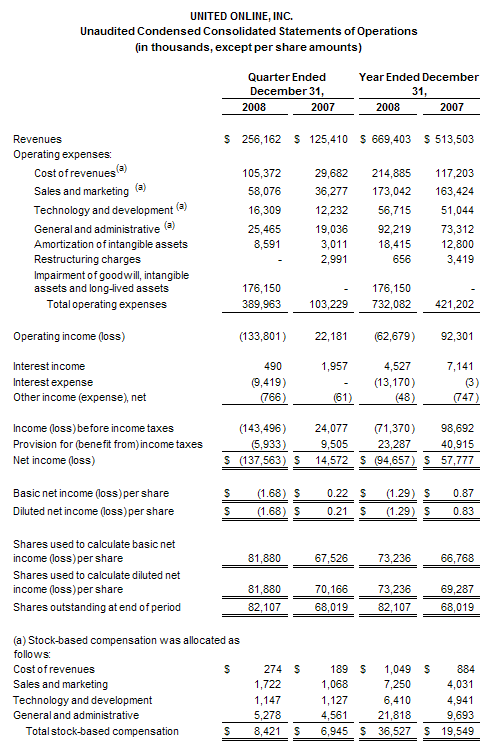
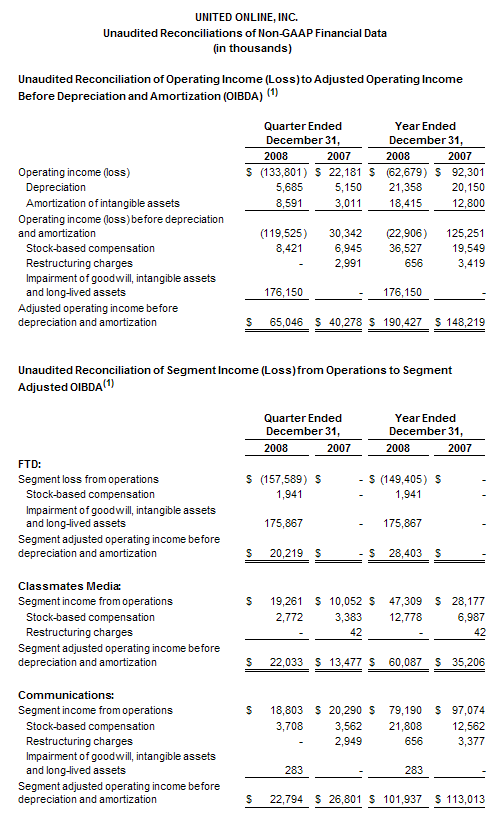
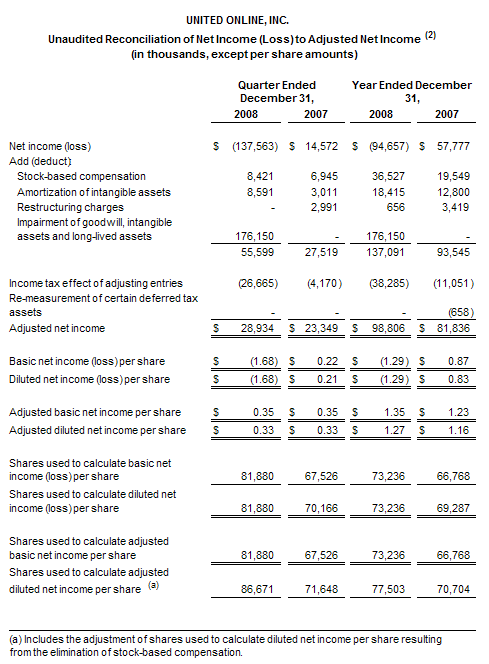
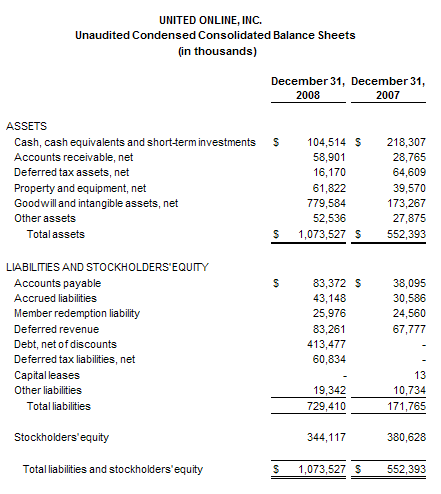
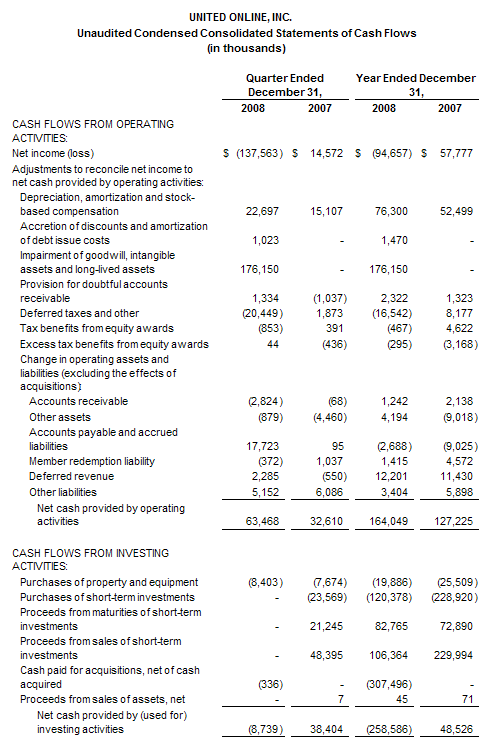
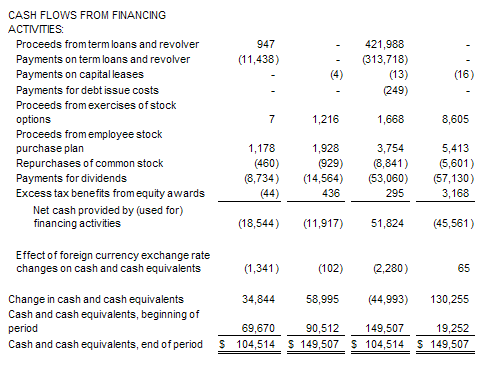
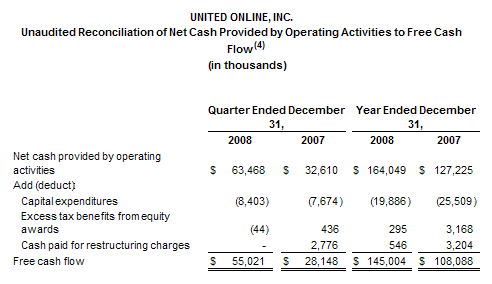
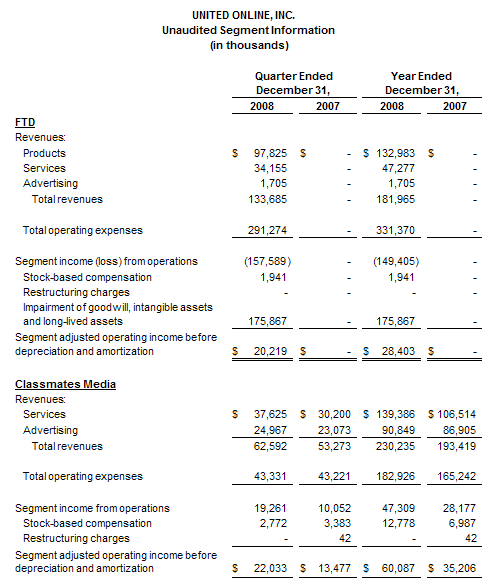

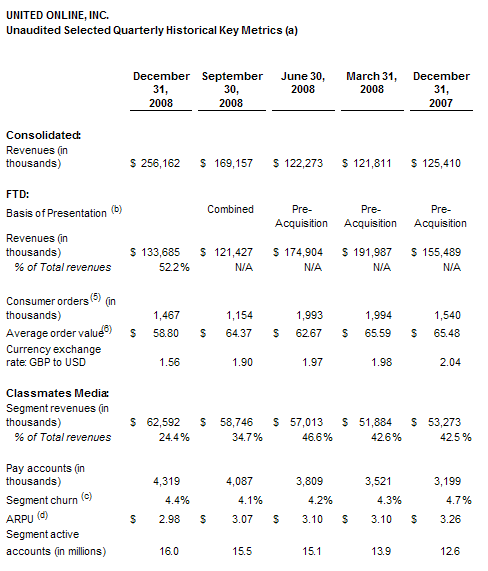
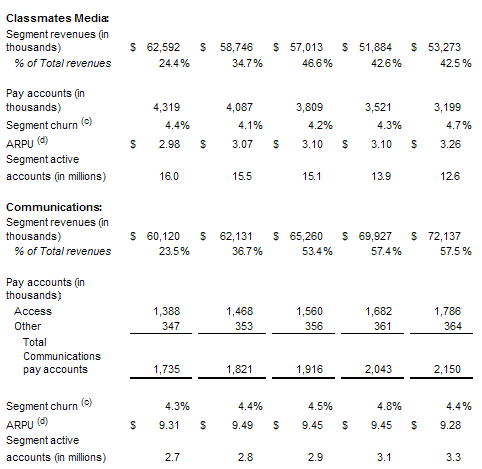
| (a) More information on the financial results for these quarters can be found in the company's filings with the Securities and Exchange Commission. | ||||||||||||||||||||
|
(b) Combined quarterly results were calculated by adding historical results prior to the acquisition (July 1, 2008 through August 25, 2008) to FTD's results following the acquisition (August 26, 2008 through September 30, 2008). Pre-acquisition results reflect the historical quarterly results of FTD prior to the acquisition date. The pre-acquisition historical results of FTD were derived from the results of FTD as disclosed in the financial statements set forth in FTD Group, Inc.'s historical filings with the Securities and Exchange Commission. The company has not verified the accuracy of the pre-acquisition historical results of FTD and makes no representations with respect to such information. | ||||||||||||||||||||
|
© Churn is calculated as the total number of pay accounts that terminated or expired in a period divided by the average number of pay accounts for the same period, divided by the number of months in that period. | ||||||||||||||||||||
|
(d) ARPU is calculated by dividing billable services revenues for a period by the average number of pay accounts for that period, divided by the number of months in that period. | ||||||||||||||||||||
SOURCE: United Online, Inc.
United Online, Inc.
Investors:
Erik Randerson, CFA
818-287-3350
investor@untd.com
or
Press:
Scott Matulis
818-287-3388
pr@untd.com
Copyright Business Wire 2009